Lab 7: Introduction to Complex Numbers
CS 145: Images and Imagination,
Spring 2014




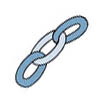
 Due Date:
Due Date:
Final submission is due Friday, April 11 before class.
This lab is worth 20 points
See policy page for late penalties.
Summary of Goals
The main goals of this lab are to:
- Learn about complex numbers .
- Learn about Object Oriented Class notation.
Complex Numbers
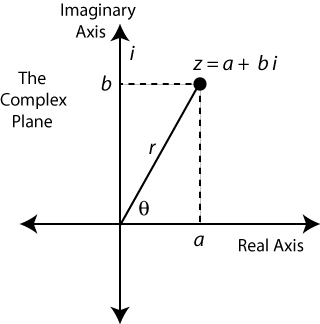 |
A complex number z can be written in standard form
z=a + b i
or in polar form as
z = r ei Θ = r(cos Θ + i sin Θ ) |
| Figure 1: The Complex Plane
|
Computing Complex Numbers by Hand: In class, we will go over the origin, definition, and operations of complex numbers. Once you are comfortable with the
concepts, work through the following problems: Complex Number Problems (pdf).
These will not be collected but you will be expected to understand how to do them.
The answers can be found here (pdf) but it is important that you try to do these
without first looking at the solutions! In class, we will go over how these answers were computed. Below, you
will also learn how to have Processing calculate the solutions for you.
Complex Numbers Processing Code
In this part of the lab, you will have Processing do the calculations for you. To do this you must:
- Include the Complex number class in your program
- Learn the syntax for creating and using complex numbers in your code.
Create a new Processing program, and copy Program 1 into it.
| Program 1: Complex Number Setup Program |
void setup() {
Complex z1 = new Complex(5, 8);
println("z1 = " + z1);
Complex z2 = new Complex(0, 6);
println("z2 = " + z2);
Complex z = Complex.cMult(z1, Complex.conjugate(z2));
println("z1 * z2_bar = " + z);
}
|
The above program shows how a complex number can be created and used.
In class we will go over this notation in more detail. Before you can run
this program, you must add the code which defines the complex numbers. We do this next.
Add a new tab to your sketch program and copy in the code below.
To add a new tab, press the small arrow next to the name tag (see picture below) and select "New Tab" :
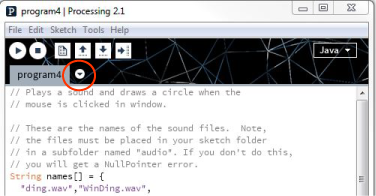
At the bottom where it says "Name for new file:", enter a name (e.g. give it the name "ComplexClass")
Next, paste the code below (Program 2) into this new tab.
Note that you need to include this in any program where you use complex numbers.
Look through this class and take note of all of the function names. These functions define
the available Complex number operations, e.g. conjugate and cMult. You must
examine the function declaration to see what parameters it take and what, if anything, it returns.
| Program 2: Complex Number Class |
// A class representing complex numbers
//**********************************************************
static class Complex {
float real = 0;
float imag= 0;
Complex() {
}
Complex(Complex c) {
real = c.real;
imag = c.imag;
}
Complex (float r, float i) {
real = r;
imag = i;
}
static Complex conjugate(Complex c) {
return new Complex(c.real, - c.imag);
}
static Complex cMult(Complex c1, Complex c2) {
float realPart = c1.real*c2.real-c1.imag*c2.imag;
float imagPart = c1.real*c2.imag + c2.real*c1.imag;
return new Complex(realPart, imagPart);
}
static Complex fMult(float a, Complex c) {
return new Complex(a*c.real, a*c.imag);
}
static Complex cAdd(Complex c1, Complex c2) {
float realPart = c1.real+c2.real;
float imagPart = c1.imag+c2.imag;
return new Complex(realPart, imagPart);
}
static Complex cSub(Complex c1, Complex c2) {
float realPart = c1.real-c2.real;
float imagPart = c1.imag-c2.imag;
return new Complex(realPart, imagPart);
}
// Computes c1/c2
static Complex cDiv(Complex c1, Complex c2) {
float topReal = c1.real*c2.real + c1.imag*c2.imag;
float topImag = c1.imag*c2.real- c1.real*c2.imag;
float bottom = c2.real*c2.real + c2.imag*c2.imag;
return new Complex(topReal/bottom, topImag/bottom);
}
// convert polar coordinates to Cartesian coordinates.
static Complex polar2Cart(float r, float degrees) {
float realPart = r*cos(radians(degrees));
float imagPart = r*sin(radians(degrees));
return new Complex(realPart, imagPart);
}
static float len(Complex c) {
return sqrt(c.real*c.real+ c.imag*c.imag);
}
static float angle(Complex c) {
if (c.real==0 && c.imag == 0) return 0;
else if (c.real >= 0 && c.imag >= 0) return asin( c.imag/len(c));
else if (c.real >= 0 && c.imag <= 0) return 2*PI - asin( -c.imag/len(c));
else if (c.real < 0 && c.imag >= 0) return PI - asin( c.imag/len(c));
else if (c.real < 0 && c.imag < 0) return PI + asin( -c.imag/len(c));
else return 1000;
}
static Complex cPow(Complex c, float exp) {
if (exp==0) return new Complex(1, 0);
float r = pow(len(c), exp);
float ang = exp*angle(c);
Complex cc = polar2Cart(r, ang*180./PI);
// println(cc.toString()+" " + c.toString());
return cc;
}
float zAbs() {
return real*real + imag*imag;
}
String toString() {
if (imag ==0) return ""+real;
else if (real == 0) return imag + "i" ;
else if (imag < 0) return real + " - " + (-imag) + "i";
return real + " + " + imag + "i";
}
}
|
Once you have added this tab, you can run the program. Experiment creating different complex numbers
and performing different operations on them.
The goal is for you to become comfortable working with the class/object syntax.
Once you understand the syntax, modify the setup program so as to check your answers to written problems 2 through 5.
Complex Transformations

Recall that a complex number can be written in standard form
z = a + b i
where a is the value of the real component and b is the value of the imaginary component. A
complex number can also be represented in polar form
z = r ei Θ
where r is its modulus or length, and Θ is the angle it makes .
When you multiply two complex numbers in polar form, you get:
z1 z2 = r1 ei Θ1
r2 ei Θ2
= r1r2 ei (Θ1+Θ2)
= r ei Θ where r = r1r2
and angle Θ = (Θ1+Θ2)
In other words, multiplying two complex numbers results in a
new complex number with modulus r equal to the product of the individual
moduli, and angle Θ equal to the sum of the individual angles.
We can also think of multiplication as a transformation.
Suppose we are given a complex number z = r ei Θ.
We want to transform it by multiplying by
another complex number w = s ei Φ. If w has a modulus of s=1,
then we get a pure rotation by the angle Φ as shown here:
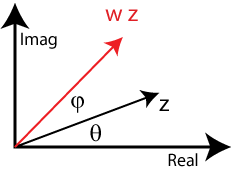 |
z → w z = ei Φ r ei Θ = r ei (Φ + Θ) |
Or, instead, if w has an angle Φ=0, then we get a pure scale by s as shown here:
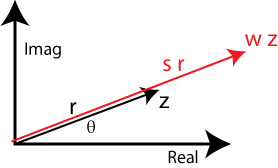 |
z → w z = s ei 0 r ei Θ = s r ei (Θ) = s z |
In general, multiplying z by w will result in a scale and rotation.
In the image below, we have transformed the image on the left to obtain the image on the right. Each pixel in the
image on the left can be thought of as being located in the complex plane at some position z. We can transform the pixel by applying some set of
complex operations which take z to z'. We then replace the pixel color at location z with the pixel color at location z'. If z' is outside the
bounds of the original image, then we set the pixel color at z to black.

|
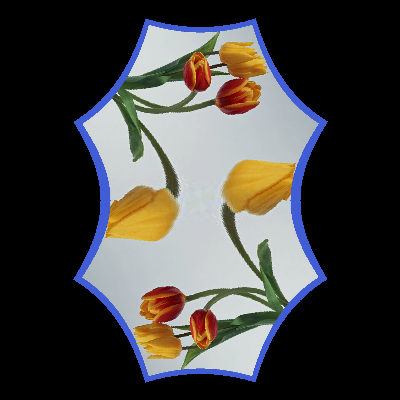
|
| Original Image | Transformed Image |
To generate similar images of your own, create a new Processing Sketch and copy the code below (Program 3)
into your sketch. As was done before, you also need to add a new tab containing the Complex Number class (Program 2). You do not need
to understand everything in the code. What you do need to understand is that the code assumes the origin
of the complex plane is at the center of the image, and the width of the image is 4, as shown in the image to the right.
The transformation we apply in the code below is z → z' = z^2 + 1. This is set in the function called transform which
is highlighted with red text.
Your task is to change the contents of this function so that you get the transformations listed below.
| Program 3: Complex Image Tranformation |
// We assume complex (0,0) is at the center of window
// w = width of the displayed complex region
float w = 4;
// h = height of the displayed complex region
float h; // this is set based on aspect ratio of image
PImage img;
String function;
// The is the complex transformation. Currently it is z = z^2 + 1
// TRY CHANGING THIS TO GET A DIFFERENT TRANSFORMED IMAGE
Complex transform(Complex c) {
return Complex.cAdd(Complex.cPow(c, 2), new Complex(1, 0));
}
void setup() {
background(0);
img = loadImage("flowers.jpg"); // read in image
h = w*img.height/img.width; // calc height of complex region
img.loadPixels(); // load in pixel colors of the image
size(img.width, img.height); // set window size to fit the image.
for (int row = 0; row< img.height; row++) {
for (int col = 0; col < img.width; col++) {
// Determine the complex number associated with this pixel row and col
Complex cc = pix2com(col, row);
// perform complex transformation
cc = transform(cc);
// convert the complex cc to its pixel location in the window
int[] pt = com2pix(cc);
// set the stroke color at (row,col) to be the color
// of the image at the transformed value
stroke(getColor(pt[0], pt[1]));
// draw the point
point(col, row);
}
}
save("transformedImage.png");
}
// Return the color at pixel (i,j).
// If i or j are outside of the image size, then return black
color getColor(int i, int j) {
if (i < 0 || i > width || j < 0 || j > img.height) return color(0, 0, 0);
else return img.get(i, j);
}
// Convert complex number to a pixel row & col
int[] com2pix(Complex c)
{
int[] p = new int[2];
p[0] = (int) ((c.real+w/2)*img.width/w);
p[1] = (int) ((h/2-c.imag)*img.height/h);
return p;
}
// Convert pixel row & col to value in the complex plane
Complex pix2com(int i, int j) {
j = img.height-j;
Complex c = new Complex();
c.real = -w/2 + w * i/img.width;
c.imag = -h/2+ h * j/img.height;
return c;
}
|
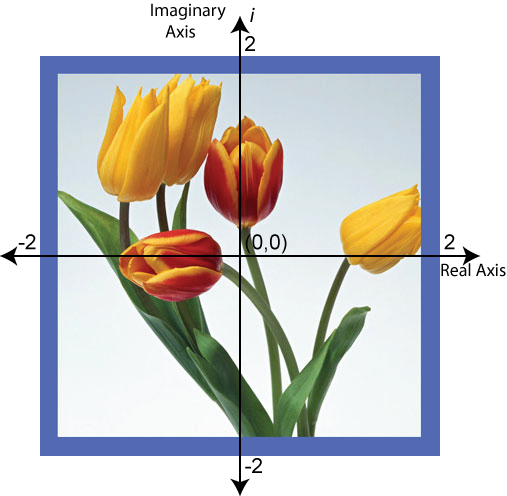
|
Your Task
Modify the transform function in the code to do the items (1-8) listed below. The images
to the right show an example of an original and transformed image. You should use your own image. Use an image
which makes the transformation easy to see.
You may use the same Processing sketch for all of the transformations. To do this, it
is recommended that you write
the transform function so that it contains each of the transformations listed below but only
returns the one you specifically want to draw. For example:
Complex transform(Complex c) {
// Compute translation:
Complex translation = ....
// Compute rotation = ...
Complex rotation = ...
etc ...
// return the name of the one you want to use:
return translation;
}
1. Translation:
z → z + w, where w=.2 + .4 i | 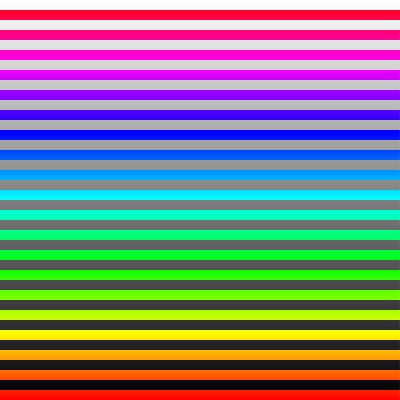 | 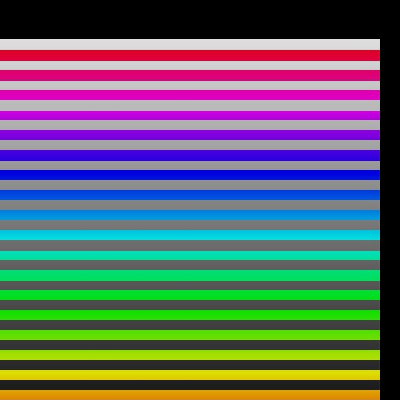 |
2. Rotation by Θ=45° :
z → w*z, where w = ei Θ
(Hint: to create w,
use the polar2Cart function) |  | 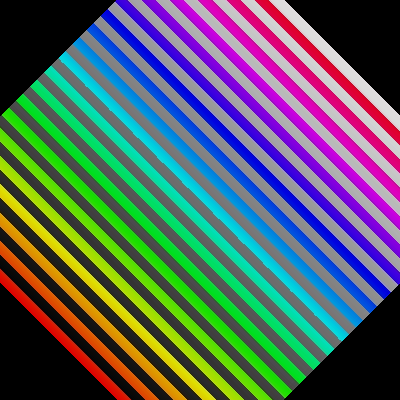 |
3. Pure scale:
z → .5*z, |  | 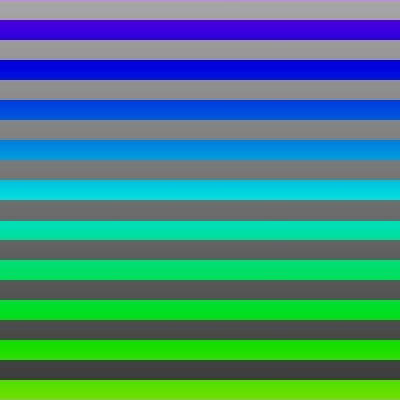 |
4. Power:
z → z5 |  | 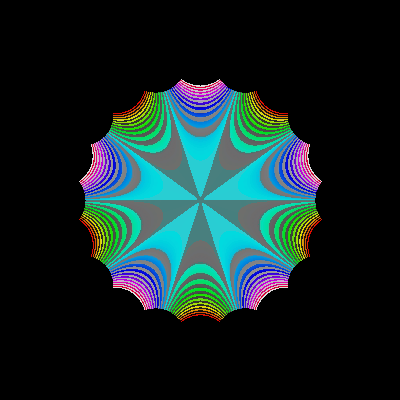 |
5. Power and translation:
z → z3 - 2 |  | 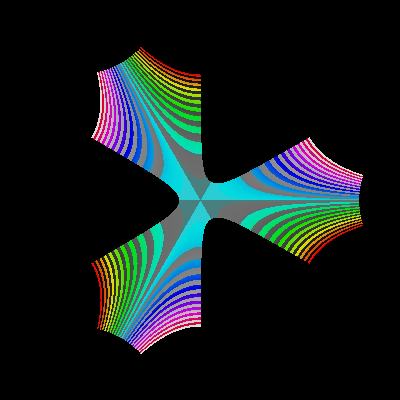 |
6. Square root:
z → √z |  | 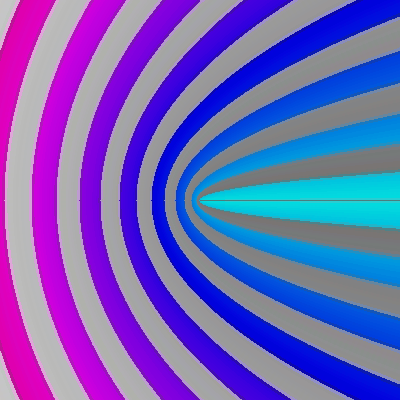 |
7. Inversion:
z → 1/z |  | 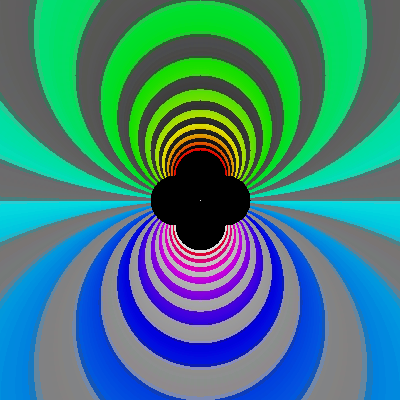 |
8. Be Creative!
Pick an interesting transformation
of your own choosing. |
To Be Submitted
At the beginning of class on Friday, April 11:
-
Place 9 images (the original and the eight transformed) on gorr-classes, in the folder CS145/Lab7/FinalImages.
It is important that you name the files by their transformation, e.g. original, scale, translation, etc.
-
Place the single Processing project containing code for each of the
eight transformations on gorr-classes, in the folder
CS145/Lab7/ProcessingProjects.
-
Be prepared to demonstrate your program in class.




















